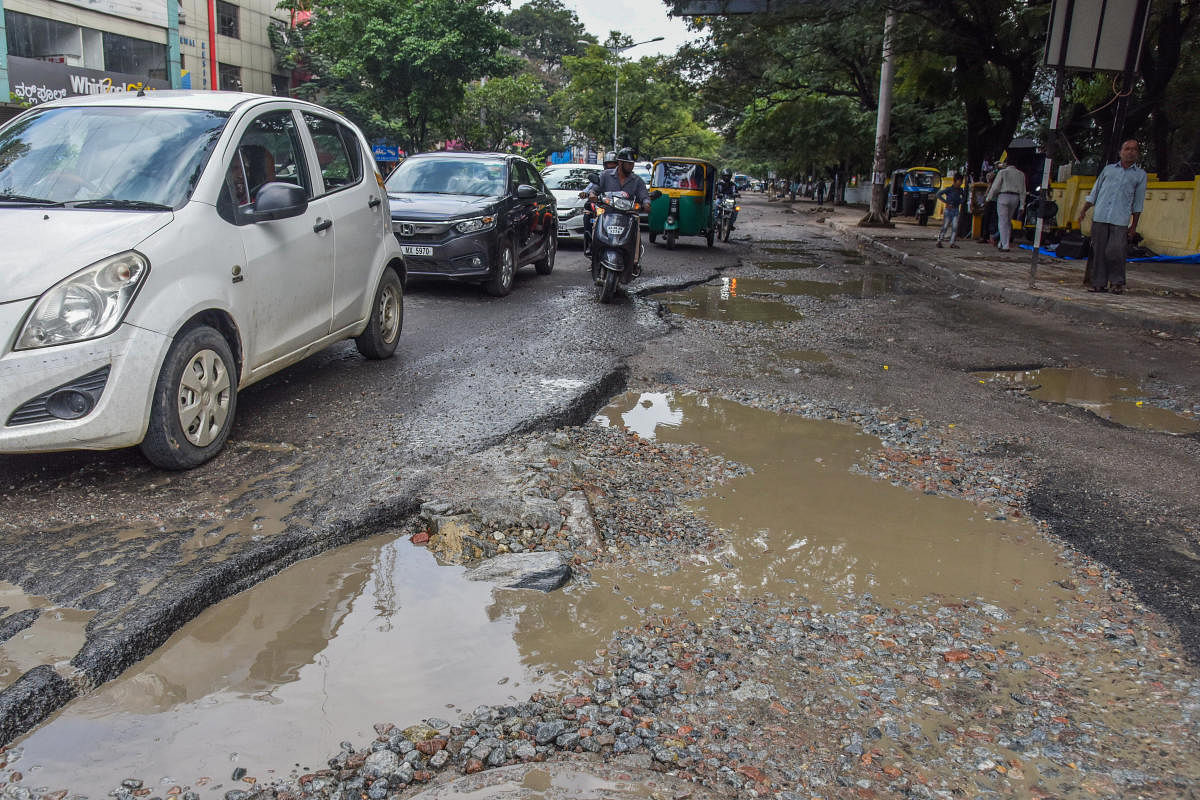
The gaping potholes and craters on Bengaluru roads are getting bigger and bigger, and little is being done to fix them.
A prominent orthopaedic hospital in Bengaluru estimates about 20 per cent of all injuries they treat are caused by bad roads.
BBMP Commissioner B H Anil Kumar says Python machines, used to fill potholes, are few in number.
“We have only two for the whole of Bengaluru and the city is expanding at a fast pace. We have eight zones and we need at least two such machines in each zone,” he says.
The roads have turned into death traps, and the BBMP can’t remain blind to them, citing inadequate equipment, says a senior officer with the Bengaluru Traffic Police.
Private companies are digging
up roads to lay cables and,
in this case, instal poles.
“They should use all means at their disposal to fix them,” says the officer. “It is a question of life and death.”
The BWSSB is laying underground water lines for 110 villages around the city now under its jurisdiction, and sometimes the contractors aren’t following protocol, the BBMP says.
“The BWSSB sometimes digs trenches and the soil is not removed. In order to bring in accountability, we will levy penalties on contractors who don’t remove soil dumped on the roads,” says Anil Kumar.
Tushar Girinath, chairman, BWSSB, concedes some contractors are slipping up.
“Laying laterals in the sewage network is a tough job. We have told our contractors to remove the soil after laying the pipes. We will impose fines on slack contractors,” says Girinath. The pipe laying for water supply projects is almost done. Some bigger pipelines have to be laid in the middle of the road in areas like Whitefield, he says.
“We hope to complete work for 1,500 km of road by the end of November. Some road work related to Cauvery fifth phase will be taken up only in 2020,” he says.
The BWSSB doesn’t intend to take up any major road cutting work for the next two years.
The potholes here are deadly. Poor maintenance of
roads is among the major causes of non-fatal
accidents, says traffic police
‘OFC companies will be hauled up’
BBMP Commissioner Anil Kumar says OFC companies are indiscriminately cutting roads. “The BBMP had earlier given them blanket permission for one year. The permissions were open-ended which meant that they could cut any road anywhere for cable laying. We have cancelled this permission and directed all OFC companies to come to us with details of roads and the timeline,” he told Metrolife.
He says the BBMP will not grant permission until companies provide details.
“We recently levied a fine of Rs 68 lakh on Airtel for violating rules. This rule applies to Reliance Jio and other companies as well. We have also caught a few agencies red-handed,” he says. He threatened to file criminal complaints against contractors who violate rules.
Problems caused by bad roads
Dr Thomas Chandy, director and chief of orthopaedics of Hosmat Orthopedic and Accident Hospital, categorises problems into two categories-- acute and chronic.
“Chronic cases come with back and neck pain. Some come with slipped discs, spondylitis in the neck and arthritis of the spine caused by wear and tear because of constant use of bad roads. The acute cases involve broken bones and fractured hands, legs and head,” he says. Chronic cases affect those above 45 years and acute injuries involve younger patients.
This is one of busiest streets for business, and it is
in pathetic shape. Potholes force motorists to
stop, swerve, and often trigger accidents.
In accidents involving two-wheelers, pillion riders are grievously injured because they have nothing to hold on to. This is called a direct injury. “An indirect injury happens when somebody tries to avoid a pothole and accidentally gets hit either by an oncoming vehicle or a vehicle speeding from behind,” explains Dr Chandy.
What is a whiplash injury?
In accidents involving four-wheelers, whiplash injuries are common. A whiplash injury occurs when the driver brakes a car suddenly. Though the vehicle has stopped, the body is going forward. The head and neck move fast when the brakes are applied. Your head goes forward and suddenly comes back. This is called a whiplash. The pain from such an accident can last for years. Most accident cases occur at night due to potholes and poor visibility, says Dr Chandy.
Police take: Potholes cause accidents
The Bengaluru traffic police say abrupt movement of vehicles contributes to freak accidents. “You don’t expect a two-wheeler to suddenly make a lateral movement at the sight of a pothole. When that happens, the vehicle at the back has the tendency to hit the vehicle in front,” an officer explains.
Potholes force motorists to stop and swerve suddenly, and that is the reason they trigger accidents.
With no segregation, the roads accommodate everything from bullock carts to superfast bikes on the same lane. The varying speed also contributes to accidents, he says.
The fastest vehicles should always be on the right-most lane. On an average, the city sees 10 to 15 non-fatal accidents a day, many of them caused by bad roads.
“Poor maintanence of roads are among the causes of non-fatal accidents,” a senior police official told Metrolife.
Road accidents
2016: 5,333
2017: 5,064
2018: 4,611
Take care of lakes, says expert
T V Ramachandra, Centre for Ecological Studies, Indian Institute of Science, believes flooding of roads worsens the condition of roads.
His recommendations:
Remove all encroachments from lakes and maintain buffer zones.
Rejuvenate water bodies and maintain them regularly.
De-silt lakes to enhance storage and recharge groundwater.